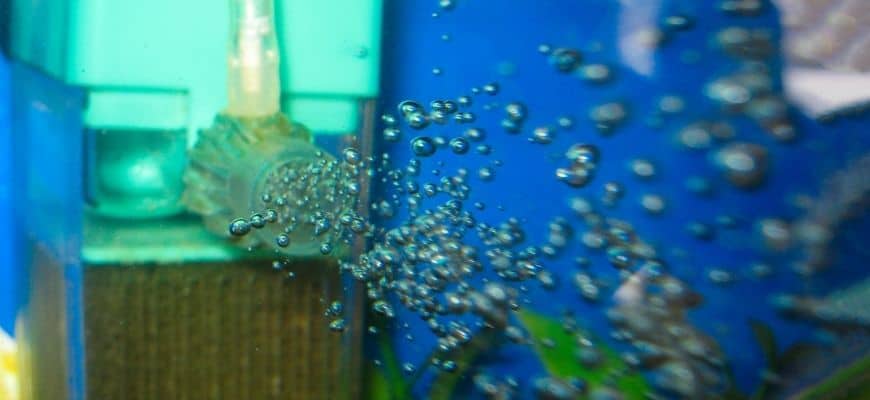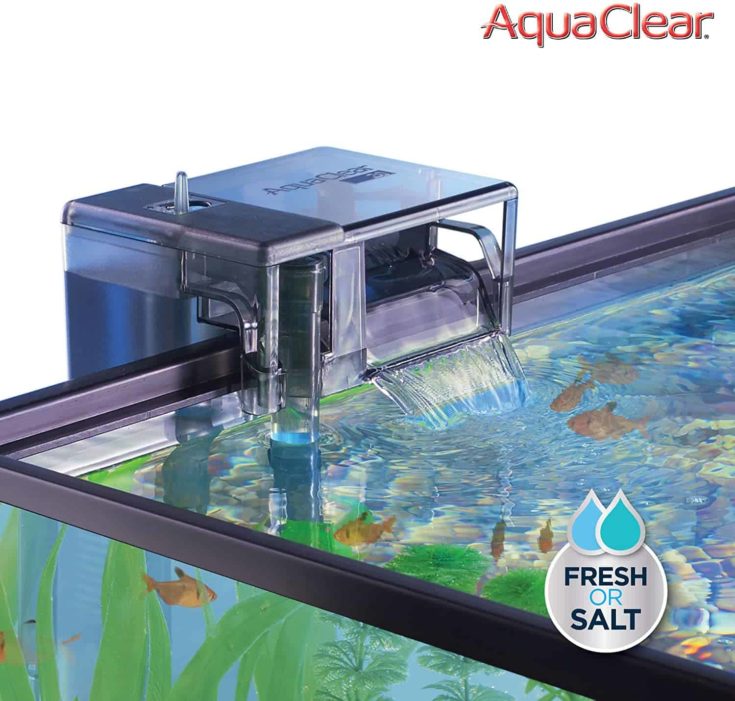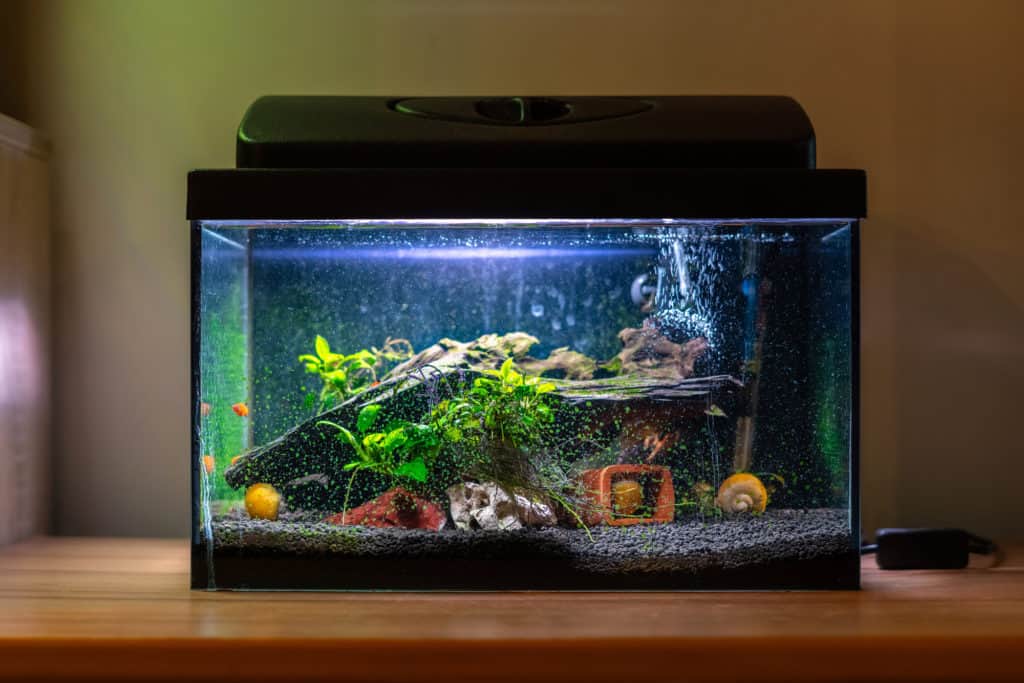We are all too familiar with the problems that arise when our fish tanks are deprived of oxygen. Not only does it leave your fish gasping for air, but it can also cause brown algae to grow. Over time, this can create anoxic conditions in your tank, which can be deadly to your fish.
Suffice to say, it’s important to do whatever you can to maintain healthy amounts of oxygen in your tank, and know what to do in the event of an oxygen crisis. In this article, we will discuss thirteen ways to increase oxygen in your fish tank.
What Are The Signs Of Low Oxygen?

Before we get into the ways to increase oxygen in your fish tank, it’s important to be able to identify when there is a problem. Some common signs that your tank is low on oxygen include:
- Fish gulping for air at the surface.
- Fish lethargy and/or lack of appetite.
- An increase in brown algae blooms
- Bubbles in the corner of the fish tank by water return.
- Condensation on aquarium walls (condensation is a good sign of high humidity and low oxygen.)
Generally, mild cases of oxygen deprivation do not result in the signs listed above. If your tank is showing these signs, it’s important to increase your oxygen levels ASAP. This article will first cover what to do in the event of an oxygen crisis, before delving into the various ways to increase oxygen in your tank.
Ways To Increase Oxygen In Your Tank In An Emergency
If you suspect that your fish tank is low on oxygen, then you should take action immediately. The first thing you need to do is check the oxygen level of your tank with a decent-quality liquid test kit. If the oxygen level is below 6 ppm, it is likely that you will need to take emergency measures to increase the oxygen level. Doing so in a timely and effective manner can be the difference between life and death for your fish.
The following are some ways to increase oxygen in your tank in emergency situations:
Pouring Water From Some Height:
This is one of the oldest tricks in the book, and it still works! Pouring water from a height into your tank will create bubbles and increase the oxygen level. Be sure to pour the water directly into the center of the tank so that it distributes evenly. The water movement from the bubbles will also be beneficial.
A good way to do this is to use a pitcher or bottles of water. If you have a garden hose, you can also pour water from the hose into the tank for a boost of instant oxygen. Just be careful not to blast your fish with the high-pressure stream, as this will likely cause more harm than good!
In addition, you should also dechlorinate your water and ensure that the pH levels are in the proper range since you will be performing these steps with whatever tap water you have on hand. We recommend using a water dechlorinator. You can also use specially formulated aquarium water from your local fish store to boost oxygen in your tank, if you don’t have dechlorinator on hand.
Large Water Change
Excess waste accumulation can decrease your aquarium’s water oxygen-carrying capacity. This is because waste build-up reduces the surface area of the water that is exposed to air. One way to solve this problem is by doing a large-scale water change using oxygen-rich freshwater.
While we do not usually recommend large water changes, they are necessary in the case of an emergency intervention. To effectively raise the concentration of oxygen in your tank, you will need to perform a water change of at least 30%. You will need to use dechlorinated tap water for this purpose.
As you perform the water change, be sure not to disturb your gravel bed, as this can result in cloudiness that decreases oxygen levels. Finally, make sure that you do not add more fish or plants while you are doing this. If you do, the oxygen levels will drop even lower than they already are.
Use Ice Cubes
Cool water typically has a higher oxygen content, so if you are desperate for a quick oxygen boost, then lowering the temperature can be useful. To do so, you can place ice cubes in zip-closed bags and float them in your tank. This can raise the oxygen level by up to 4 ppm.
It is important that you do not add the ice cubes directly to your tank as this can cause dangerous water fluctuations. You also run the risk of introducing impurities and bacteria into your tank with the ice cubes as it melts. Using the ziplock bag method allows you to gradually lower water temperatures without these pitfalls.
Another thing you should look out for is staying within the preferred temperature range of your fish. For example, if your fish prefers temperatures between 70 and 78 degrees Fahrenheit, shoot for something on the cooler end of that spectrum. Colder water may raise oxygen levels, but it can also be harmful or deadly to your fish if the temperature is too low.
Use A Battery-Powered Air Pump
Air pumps are a must-have for aquariums in general, so it might be odd to spot this recommendation under emergency advice. However, battery-operated air pumps can be a godsend if your oxygen emergency is caused by a power outage. Electric-driven air pumps will not work in the event of a power outage, but battery-powered pumps will continue to function as normal.
If you have an extra battery around, or if you can borrow one from a friend, this can be a lifesaver. Keep in mind that the pump will only last as long as the battery does, so it is important to have a plan for recharging or replacing the battery.
Because these types of air pumps tend to be smaller and more portable, they may result in a weaker water flow than your typical electric-driven air pump. If this is the case, you may need to use more than one pump in order to sufficiently oxygenate your tank.
Ways To Increase Oxygen In The Fish Tank (Permanent Solutions)
Now that we have covered the temporary measures to take in case of a sudden or short-term oxygen decrease, let’s move on to some permanent solutions that you can implement long-term. These solutions will maintain a healthy oxygen level in your tank without you having to worry about it!
Use A HOB Filter

A Hang-On Back (HOB) Filter is a popular choice for fish tanks as it is easy to use and does not take up a lot of space. In addition, this type of aquarium filter works extremely well as oxygenators. They work by drawing water into the filter and processing it before releasing it via the filter outlet. This creates turbulence in the water, which increases the amount of oxygen that the filtered water contains.
Another benefit of using a HOB filter is that it helps to maintain your water quality. This is important because subpar water parameters can lead to a decrease in oxygen levels. So, not only will a HOB filter help to increase oxygen levels, it will also work to keep your tank healthy overall.
Though a HOB filter can do wonders for the oxygen levels in your tank, it is known for being one of the less powerful filter types. Aquarists with larger tanks might prefer strong filter types such as a canister filter. Unfortunately, the filter output of these types of filters is typically located below the water surface, making it more difficult for it to aerate the tank via water surface agitation. Thankfully, the next entry on our list provides a solution.
Use A Spray Bar
A spray bar is typically used in conjunction with canister filters. This works by allowing the water to hit the surface of your tank before it flows back into your filtration system. This creates turbulence in the water which, as we know, increases the oxygen-carrying capacity of the water.
When using a spray bar along with a canister filter, it is important to first install the spray bar on the outlet tubing that leads into your filtration system. After this, simply place the spray bar at an angle such that it faces towards one side of your tank. This will create a gentle waterfall effect that disperses oxygen-rich water throughout the tank.
Though a spray bar is a great way to supply most tanks with sufficient oxygen, it can be less effective on tanks that are wider than they are deep. In these cases, it is best to use multiple spray bars in order to achieve the desired level of oxygenation.
Use Fountain Heads
The next suggestion is tons of fun! Fountain heads create a stunning visual effect in your tank while also increasing the oxygen levels. Like spray bars, fountain heads work by agitating the surface of the water, which increases the amount of oxygen that is dissolved in it.
There are a variety of fountain heads to choose from, so it is important to find one that will fit your specific tank size and décor. We recommend opting for one that has an adjustable flow rate. This will allow you to control the water flow in order to minimize any negative effects that strong currents might have on your fish.
Though fountain heads are very easy to install, they can cause a bit of a mess because of all the water droplets that they produce. Therefore, these are best for tanks or ponds with a larger surface area of stagnant water. They make a great alternative to spray bars!
Use Air Pump
We’ve discussed using battery-powered air pumps in oxygen emergencies, but any type of aquarium air pump can also be used on a regular basis to increase oxygen levels. This is because air pumps create air bubbles that rise to the surface of the tank and disperse oxygen into the surrounding water.
In order to use an air pump effectively as an oxygenator, it is important to place it in a location where the bubbles will have plenty of time to reach the water surface. This will maximize oxygen exchange between the water and the air bubbles. Nothing starves your tank of oxygen like a lack of water movement, so air pumps are very helpful in this regard.
The downside to using an aquarium air pump is that it can be quite noisy. If this is something that will bother you, you might want to consider placing your air pump in a different location away from where you sit when watching TV or working on your computer. Or, if silence isn’t important to you, you can always consider using a water pump that runs off of electricity.
Wavemaker
Another way to increase the oxygen levels in your tank is by using a wavemaker. Wavemakers break the surface tension of water, which helps with water circulation. This in turn increases its oxygen content because as the waves move across the surface of the tank, the wavemaker brings fresh air into contact with the water, which allows the exchange of gases to take place.
Wavemakers are available in both electronic and mechanical varieties. While both work well for increasing oxygen levels, we recommend using a wavemaker that is primarily powered by electricity over one that uses a battery because they tend to be more energy-efficient and quieter than battery-powered models. Also, be sure to position your wavemaker correctly! You want to maximize the benefits it provides, and this is one of the best ways to do so.
An excellent feature of wavemakers is that you can use them to create various water flow speeds throughout the day in order to accommodate the different needs of your fish. This is a great feature because it eliminates the need to use multiple devices in order to achieve the desired level of oxygenation.
Stocking Your Tank Correctly

Overstocked tanks are another cause of low oxygen levels. When there are too many fish in a tank, they use up the available oxygen much more quickly than they would if there were fewer fish present. Naturally, this causes the oxygen concentration in freshwater tanks to plummet.
When stocking your tank, only add as many fish as will be able to comfortably fit on its surface. Another helpful tip is to include more non-fish inhabitants, such as plants, in your tank in order to provide a more natural environment for your fish and reduce the amount of competition for oxygen.
If a lack of oxygen remains an issue in your tank even after you have taken these tips into consideration, you may need to consider moving your fish to larger tanks that can accommodate their growing oxygen needs. This will prevent you from having to deal with further health issues caused by a lack of oxygen in the tank.
Caring For Your Plants
Aquarium plants are important for increasing oxygen levels in a tank because they extract carbon dioxide from the water and release oxygen. This form of gas exchange not only provides fish with a more natural environment to live in but also plays an important role in keeping the oxygen levels up.
To help you and your fish enjoy the benefits of plants, we recommend using beginner-friendly live plants that will quickly fill up the tank and create a thicker canopy. Carpet plants such as Java Moss and Dwarf Hairgrass are great options because they grow very quickly to create a stunning visual effect in your tank.
On top of selecting the right plants to stock your tank, you also need to care for them properly. To give your plants the best chance at thriving in a tank, provide them with proper lighting and keep all of your plants well-fed with the right aqua-plant food. Even easy-going species such as Anubias plants will benefit from the extra care.
Controlling Temperature Rises
Having an elevated water temperature in your tank is bad news for both your fish and the oxygen levels. Not only does warm tank water make it difficult for fish to breathe, but they also encourage the growth of harmful bacteria that can quickly deplete the available oxygen in a tank.
One way to combat temperature rises is by installing a chiller unit into your aquarium system. Chiller units work by using a refrigerant to lower the temperature of the water, which in turn reduces the need for oxygen. If you live in a warm climate or your tank tends to run hot, installing a chiller unit can be a great way to ensure that your fish always have enough oxygen in the water.
Of course, this isn’t to say that you should only house your fish in cold water. Different fish species thrive in different water temperatures, so it is important to research the ideal temperature range for each of your fish before you make a purchase.
Taking Care With Chemicals And Medications
We always advocate for chemicals and medications as a last resort after all other options have been exhausted. Used effectively, chemicals and medications can be a quick and effective solution to fatalities and illnesses, but used improperly they can be very harmful.
One of the most important things to keep in mind when using any chemicals or medications is that they tend to reduce the oxygen content in your tank water. When you are medicating your fish, always ensure that there is an abundance of oxygen available in the water and monitor the oxygen levels closely. If you notice a significant drop in oxygen levels, discontinue the use of the medication and take steps to increase the oxygen levels immediately.
Chemicals can also come from your water supply. For example, tap water is often treated with chlorine, which can be very harmful to fish. To provide your fish with fresh, dechlorinated water, we recommend testing water from an unfamiliar source before adding it to your tank. You can also use a water conditioner such as Prime to remove chlorine and other harmful chemicals from the water.
Conclusion
Nothing is worse than finding an oxygen-starved tank on your hands, so take steps to prevent this from happening in the first place. By following our simple guidelines, you can ensure that your fish have plenty of oxygen available for them to breathe and thrive in their home!
Did you enjoy this article? If you did, please share it with your fellow fishkeeping enthusiasts! You never know who might find this helpful. Also, if you have any questions or comments, please feel free to leave them in the comments section below. We love hearing from our readers, and we greatly appreciate your support!
